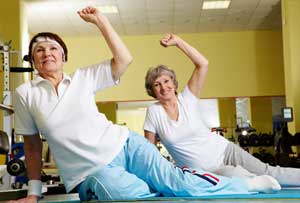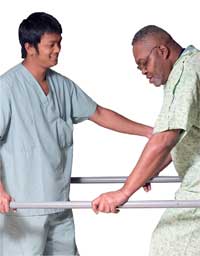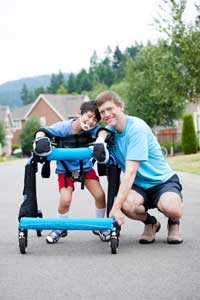 Multiple sclerosis presents special challenges due to the
unpredictable nature of the disease, temperature sensitivity and fatigue issues. Yet, research clearly indicates the benefits of an active lifestyle for individuals with MS. Unfortunately, most individuals do not get sufficient physical activity for
these health benefits to occur. This places them at increased risk for cardiovascular disease, diabetes and colon cancer, among other disorders.
Multiple sclerosis presents special challenges due to the
unpredictable nature of the disease, temperature sensitivity and fatigue issues. Yet, research clearly indicates the benefits of an active lifestyle for individuals with MS. Unfortunately, most individuals do not get sufficient physical activity for
these health benefits to occur. This places them at increased risk for cardiovascular disease, diabetes and colon cancer, among other disorders.
Exercise can change the course of MS patients’ lives by minimizing the de-conditioning process and maintaining an optimal level of physical functioning. Individuals with mild to moderate MS can achieve similar fitness, health-related and psychological benefits as those without the illness. Exercise improves cardio-respiratory, muscle, bowel and bladder functions while decreasing depression and fatigue. Exercise may even have a role in pain management. In addition to the health and fitness benefits, participating in a formal exercise program builds a social support network and is a source of caregiver respite.
Physical activity helps people with MS feel better about themselves. In one study, participants described the downward spiral from diagnosis through an assortment of personal losses including erosion of self-esteem and competence, and depletion of personal assets (e.g., career, home, cars, recreational property). They experienced periods of depression, loss of independence, identity erosion and social detachment. Becoming involved in physical activity resulted in increased social activity and a renewal of self-esteem, confidence and competency.
The health benefits of physical activity for persons with MS are unequivocal, and are associated with decreased risk for heart disease, diabetes and various forms of cancer, as well as increased quality of life.
 For individuals with a spinal cord injury,
regular exercise leads to significant reductions in pain, stress and depression. Although people with a spinal cord injury face significant mobility and adaptive challenges, physical and emotional well-being.
For individuals with a spinal cord injury,
regular exercise leads to significant reductions in pain, stress and depression. Although people with a spinal cord injury face significant mobility and adaptive challenges, physical and emotional well-being.
 Parkinson’s disease is a neurological disorder
with many motor symptoms. Physical therapy programs for building core strength can produce significant reductions in weakness and stiffness. Physically active individuals with Parkinson’s disease have a lower mortality rate, better quality of life
and increased ability to carry out activities of daily living than less active individuals. Exercise may lessen the severity of Parkinson’s disease or even decrease the risk of developing and the illness in the first place..
Parkinson’s disease is a neurological disorder
with many motor symptoms. Physical therapy programs for building core strength can produce significant reductions in weakness and stiffness. Physically active individuals with Parkinson’s disease have a lower mortality rate, better quality of life
and increased ability to carry out activities of daily living than less active individuals. Exercise may lessen the severity of Parkinson’s disease or even decrease the risk of developing and the illness in the first place..
Exercise improves physical functioning, health-related quality of life, strength, balance and gait speed in persons with Parkinson’s disease. However, evidence is less clear regarding the impact of exercise on depression in this group.
 Increased motor activity for individuals
with Cerebral Palsy leads to better physical and mental health, enhances cognitive function and promotes neural growth and recovery of function in damaged nervous systems. To maximize benefit, physical activity treatments should be based on more intense
training procedures, lifestyle modifications and mobility enhancing devices.
Increased motor activity for individuals
with Cerebral Palsy leads to better physical and mental health, enhances cognitive function and promotes neural growth and recovery of function in damaged nervous systems. To maximize benefit, physical activity treatments should be based on more intense
training procedures, lifestyle modifications and mobility enhancing devices.